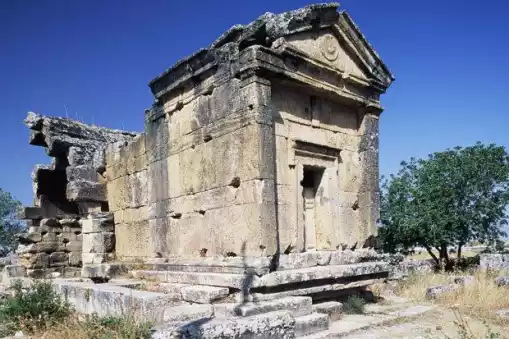Hell's Gate Discovered
Ancient 'Gate To Hell' Uncovered In Turkey... And It Can Kill Anyone Who Gets Too Close (Photos)
2018/02/19 19:17:09tori.ng
GATE TO HELL: Other ruins around the ancient greek city of Hierapolis in Turkey
An ancient site dubbed the “Gate to Hell” emitted a deadly gas that killed anyone who got too close, scientists have discovered.
Boffins have been probing the ancient site in Turkey – also known as Hades’ Gate – which was believed to be a passage into the underworld by the ancient Greeks.
Myth tales claim people would drop down dead when they entered the mysterious stone grotto located beneath the temple at Hierapolis.
It was said to be filled with the deadly breath of the Greek god of death who ruled over the underworld, Hades.
But now scientists have found the tales of people dropping dead at the site could have been more than just stories.
Researchers have discovered there is evidence the site, in modern day Denizli, was once filled with concentrated deadly gas – and could still be fatal to this day.
Professor Hardy Pfanz, from the University of Duisburg-Essen, Germany, led the study which discovered the ancient ruins still emit highly concentrated levels of carbon dioxide.
The cave sits above the Badadag fault line, meaning toxic gases would have escaped the Earth’s crust and filled the grotto.
HIERAPOLIS: Ancient Greeks built a temple dedicated to Hades over the 'Gate to Hell'
Boffins believe it was this – not the breath of an ancient god – that would have caused the terrifying mysterious deaths at the site.
The study said: "In a grotto below the temple of Pluto, CO2 was found to be at deadly concentrations of up to 91%.
"Astonishingly, these vapuors are still emitted in concentrations that nowadays kill insects, birds and mammals.”
Ancient Greeks believed Hades was the brother of Zeus, the god of the sky, and was given the duty of looking after the dead and ruling the underworld.
Ancient geographer Strabo revealed he witnessed animals being sacrificed in the cave in a thick cloud of vapour in 17AD.
He said: "“Now to those who approach anywhere around the enclosure the air is harmless, since the outside is free from that vapor in calm weather, but any animal that passes inside meets instant death.
“Bulls that are led into it fall and are dragged out dead.”
The scientists' study was published in the journal Archaeological and Anthropological Sciences.
It added: “Our measurements confirm the presence of geogenic CO2 in concentrations that explain ancient stories of killed bulls, rams, and songbirds during religious ceremonies.
"They also strongly corroborate that at least in the case of Hierapolis, ancient writers like Strabo or Plinius described a mystic phenomenon very exactly without much exaggeration."
Source: Daily Star UK
Source

Hi! I am a robot. I just upvoted you! I found similar content that readers might be interested in:
https://www.dailystar.co.uk/news/world-news/683015/Ancient-Discovery-Greek-Gate-to-Hell-Turkey-Hierapolis-Hades-Underworld-CO2-Gas-Science
Gate of hell huh...
Yep
how true is it